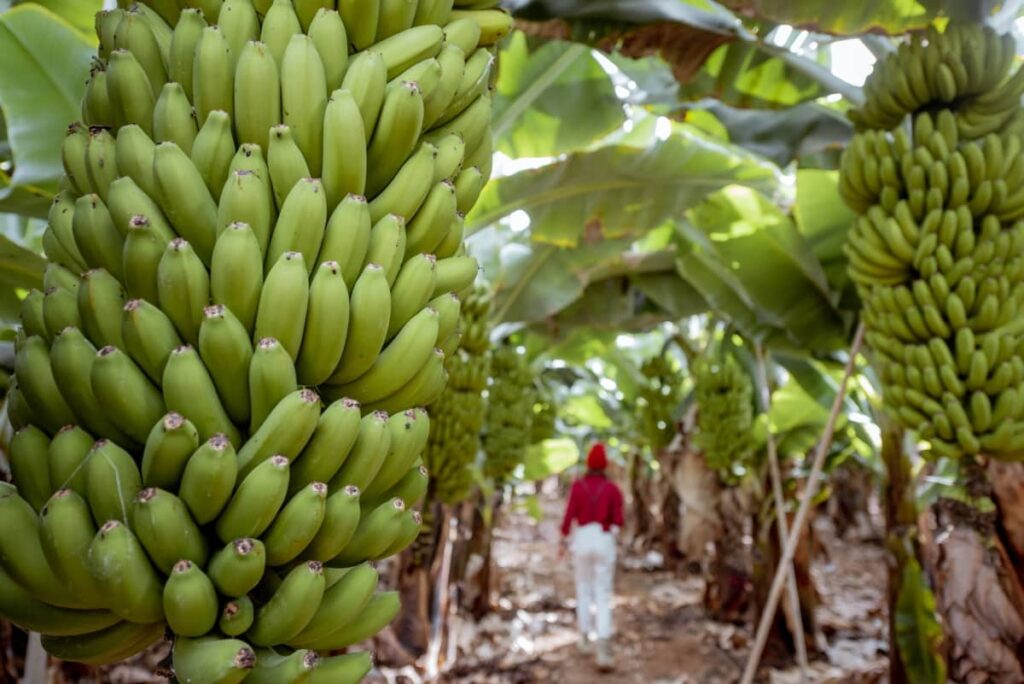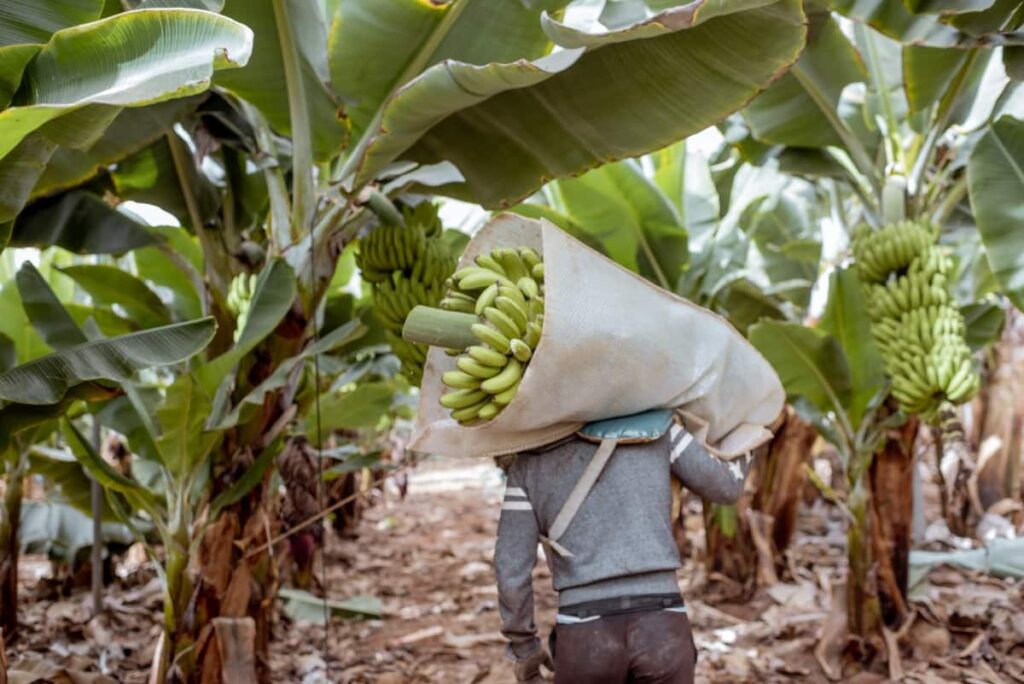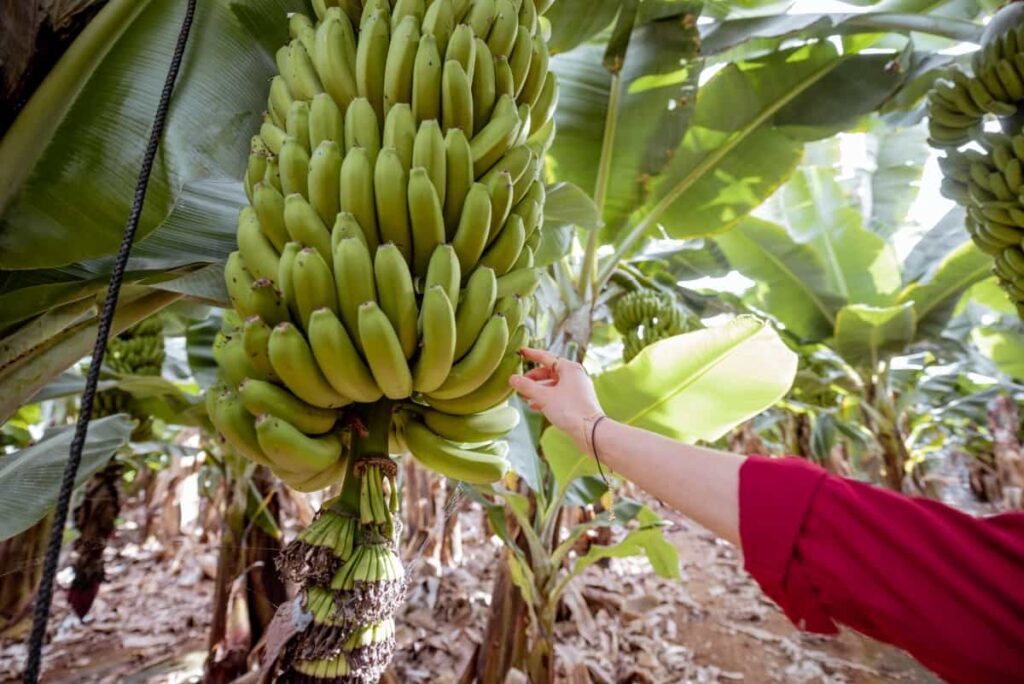Bananas, a globally popular fruit, undergo diverse cultivation methods that exert a substantial influence on both their quantity and quality. Effective banana cultivation involves specific practices like banana bunch spray, bunch injection, and bunch feeding. The choice of the best intercrop for bananas, adherence to a banana plant fertilizer chart, and understanding banana yield per hectare are crucial for successful banana cultivation.

How to Increase Banana Yield
Choose High-Yielding and Disease-Resistant Banana Varieties
Selecting high-yielding and disease-resistant banana varieties is essential for maximizing production. These varieties often have better resistance to common diseases and pests, ensuring healthier plants and more consistent yields. By choosing these varieties, farmers can reduce losses due to disease and increase the overall banana yield per hectare. In regions susceptible to specific banana diseases or pests, implementing this strategy is of utmost significance, as resistance can be the decisive factor between a productive harvest and a complete crop failure.
Optimizing Soil Nutrients and pH for Banana Cultivation
Soil health is a critical component of banana cultivation. Maintaining appropriate nutrient levels and achieving an ideal pH balance in the soil are imperative for the well-being of banana plants. Routine soil analysis facilitates precise fertilizer application based on a prescribed banana plant nutrient guideline, guaranteeing optimal nutrient provision for the plants. Adjusting the soil pH to suit banana plants can significantly improve nutrient uptake, leading to better growth and higher yields.
Effective Banana Plant Spacing and Crop Rotation Strategies
Proper spacing of banana plants is vital for ensuring adequate sunlight, air circulation, and nutrient availability for each plant. Overcrowded plants compete for these resources, leading to lower yields. Crop rotation is another important strategy, helping to maintain soil health and reduce the build-up of pests and diseases. Implementing crop rotation with the best intercrop for bananas can enhance soil fertility and prevent the exhaustion of specific nutrients.
Irrigation Management for Healthy Banana Plants: Choose Drip for High Yields
Effective irrigation is crucial for banana cultivation. Drip irrigation is often the best choice as it conserves water and delivers it directly to the plant’s roots, reducing waste and preventing waterlogging. Proper water management ensures that banana plants are neither over nor under-watered, both of which can negatively impact fruit size and yield. Regular monitoring and adjustment of irrigation schedules based on weather conditions and plant needs can significantly boost banana production.
In case you missed it: Cavendish Banana Farming in the Philippines: Cultivation Practices

Apply Fertilizers and Pesticides on Time
Timely application of fertilizers and pesticides is key to achieving high banana yields. Following a well-planned schedule based on the banana plant fertilizer chart ensures that the plants receive the necessary nutrients at the right growth stages. Similarly, effective pest and disease control through timely pesticide application can prevent significant crop losses. Using banana bunch spray or bunch injection methods can be particularly effective in managing specific pest and disease challenges.
Pruning and Training Techniques for Improved Fruit Size and Yield
Pruning and training banana plants are important techniques to improve fruit size and yield. Removing excess leaves and suckers helps direct the plant’s energy towards fruit production. Training techniques, such as supporting the banana bunch, can prevent damage and promote the development of larger and better-quality fruits. Routine pruning and training methods enhance air circulation and light penetration, thereby decreasing disease susceptibility and promoting overall plant well-being.
Harvesting and Post-Harvest Management for Optimal Quality
Harvesting bananas at the right time and handling them carefully post-harvest are crucial for maintaining fruit quality. Bananas should be harvested when they have reached full size but before they ripen on the plant. Proper post-harvest handling, including careful transportation and storage, minimizes damage and extends the shelf life of the fruit. Effective post-harvest management is essential for ensuring that the bananas reach the consumer in the best possible condition, maximizing both quality and yield.
Integrated Pest and Disease Management for Healthy Banana Crops
Integrated Pest and Disease Management (IPDM) represents a comprehensive strategy for effectively addressing pest and disease issues within banana cultivation. This approach combines cultural, biological, and chemical methods to control pests and diseases effectively. Practices like crop rotation, the use of disease-resistant varieties, and proper sanitation reduce the prevalence of pests and diseases. When chemical controls are necessary, using them judiciously as part of an IPDM strategy can reduce the overall reliance on pesticides, promoting a more sustainable and environmentally friendly approach to banana cultivation.
In case you missed it: Banana Farming Information Guide

Mulching Techniques for Soil Conservation and Weed Control
Mulching is a practical approach to soil conservation and weed control in banana cultivation. By covering the soil around banana plants with organic materials like straw or leaves, mulching helps retain soil moisture, regulate temperature, and prevent weed growth. This method minimizes the necessity for frequent irrigation and herbicide usage, promoting both environmental sustainability and cost-efficiency. Moreover, as the mulch breaks down, it enhances the soil’s nutrient content, thereby fostering the well-being and development of banana plants.
High-Density Planting for Increased Yield per Acre
High-density planting is a technique used to maximize banana yield per acre. By planting banana trees closer together than traditional spacing methods, this approach increases the number of plants per unit area, leading to a higher overall yield. Efficient management is essential to ensure that every plant receives adequate sunlight, water, and nutrients. High-density planting can be highly effective, especially when combined with appropriate banana plant fertilizers, irrigation, and pest management strategies. It is a popular choice for maximizing production in limited spaces.
Best Fertilizers to Increase Banana Yield
| Fertilizer Type | NPK Ratio | Application Timing | Cost (per kg) |
| Urea | 46-0-0 | Pre-flowering | $0.50 |
| Potassium Sulfate | 0-0-50 | Fruit Development | $0.75 |
| Triple Super Phosphate | 0-46-0 | Planting Stage | $0.60 |
| Complete Fertilizer | 15-15-15 | Growth Stage | $0.55 |
| Organic Compost | Varies | Throughout Growth | $0.40 |
| Calcium Nitrate | 15.5-0-0 + 19% Ca | Pre-flowering | $0.65 |
| Magnesium Sulfate (Epsom Salt) | 0-0-0 + 10% Mg | Fruit Development | $0.30 |
In case you missed it: Red Banana Farming in India: How to Start, Cultivation Practices, and Panting to Harvesting Guide

Conclusion
Increasing banana yield and improving fruit quality involves a multifaceted approach that includes selecting the right varieties, optimizing soil nutrients, implementing effective spacing and crop rotation strategies, managing irrigation efficiently, and timely application of fertilizers and pesticides. Techniques like pruning, training, mulching, and high-density planting play a crucial role, as do the harvesting and post-harvest processes. Integrated Pest and Disease Management is essential for maintaining healthy crops.
- Crops Grown in Summer Season: Best Choices for Summer Gardening
- Organic Pest Control for Tomato Farming
- How to Maximize Sheep Farming Profit
- Broccoli Varieties: Choosing the Right Cultivars for Your Farm
- How to Raise Pigs in Your Own Backyard: A Comprehensive Guide
- Budget Friendly Sheep Shed Ideas: Cheap and Low-Cost Tips
- How Much Do Cattle Farmers Make: Revenue Streams in Cattle Farming
- Management Pests and Diseases in Your Cotton Field
- Sheep Farming Business Plan for Beginners
